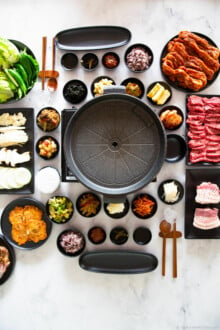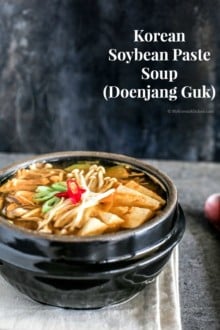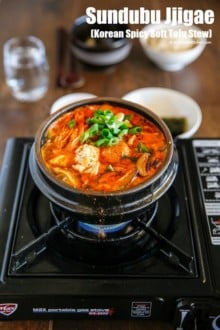My best doenjang jjigae recipe! Learn how to make staple Korean stew – doenjang jjigae (Korean soybean paste stew) at home. It’s hearty and comforting!
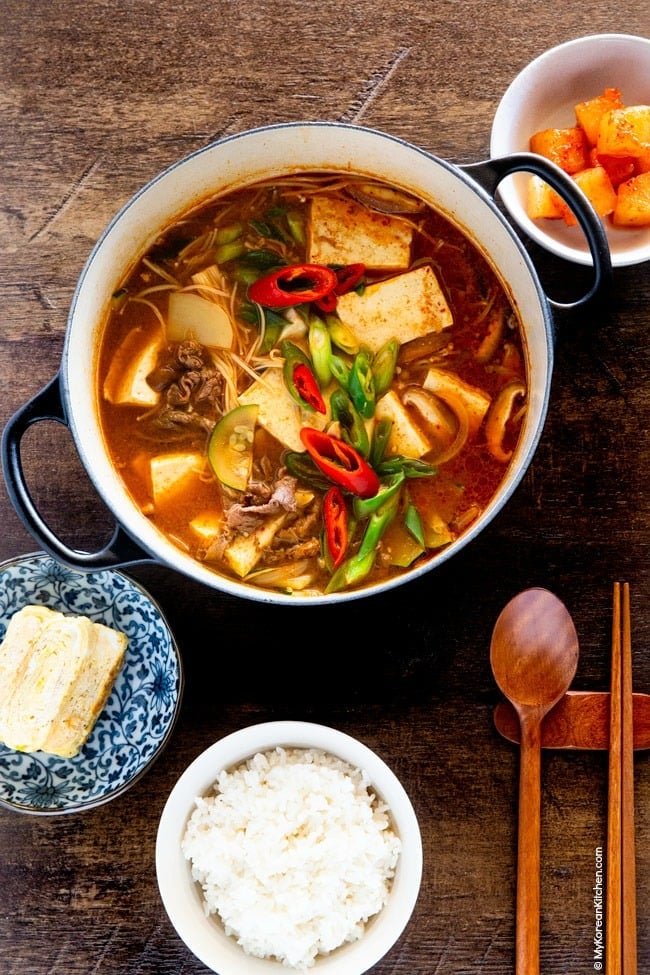
What is Doenjang Jjigae
Doenjang jjigae (된장찌개) is one of the most popular Korean stew dishes made with Korean soybean paste (doenjang), a type of fermented bean paste made of soybean and brine.
Typically, special soup stock, meat (or seafood), tofu and vegetables of your choice is added into the stew. Popular vegetables here are zucchini, potatoes, onions, and Korean or daikon radishes.
While some Koreans still make doenjang at home, many Koreans including myself buy it from a Korean grocer from a convenience factor. In case you’re wondering, the doenjang below is what I used in this recipe.
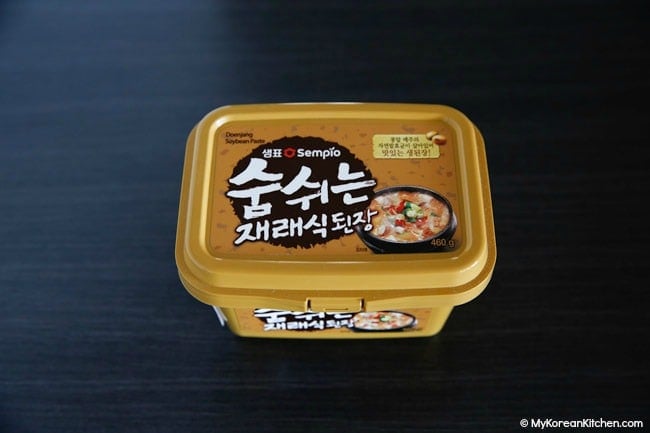
Like bolognese sauce varies slightly from household to household, doenjang jjigae recipe varies in Korean households too.
Today’s recipe is specially made with beef, rice water, and ssamjang (Korean spicy dipping sauce) among other typical doenjang jjigae ingredients. Do you want to find out more?
Key Features & Tips
- Beef brisket or any cuts that are suitable for soup and stew.
Beef provides additional protein, but it also adds nice savory flavor into the stew. Popular cuts for soup and stew are chadolbagi (차돌박이) and usamgyeop (우삼겹) – beef plate. I’ve also made it with shabu shabu cut beef, but I find that the meat is a bit too lean. So if you boil it for a long time, it can get tough.
So my preference is using the fatty part of beef, but trimming off excess fat. If you’re trimming the fat off, you may want to use more meat to compensate for the loss of weight from the fat.
- Rice water (water obtained from rinsing rice, known as ssaltteumul (쌀뜨물)) – Typically when I make Korean soup or stew, I use dried anchovy and dried kelp based stock. You can see the example from my other soybean paste soup recipe – doenjang guk.
But another popular soup stock choice is rice water and I wanted to give it a try in this recipe. The added bonus here is that it’s more convenient than dried anchovy and dried kelp soup stock. All you need to do is save some rice water when you rinse your rice. I would suggest saving the water from the 2-3 rounds of rinsing.
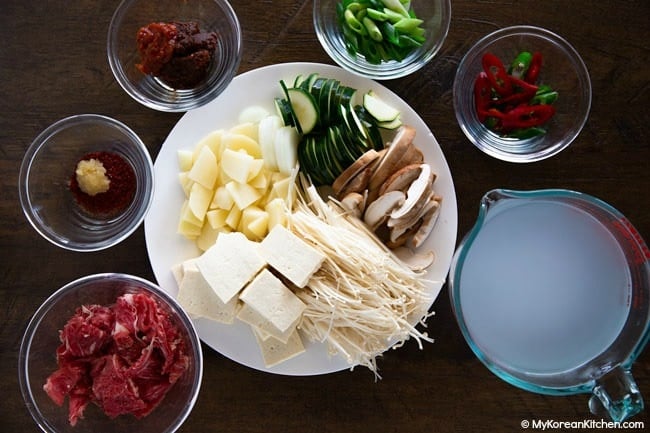
- Ssamjang (Korean spicy dipping sauce) – This is not a common ingredient in soup/stew recipes as gochujang, but I read somewhere that this is the key ingredient in making restaurant style doenjang jjigae.! Secret is out now. 😉
I’ve never added ssamjang in my doenjang jjigae recipe in the past, but boy! it does make a difference. It gives stronger and more pungent flavor, which I quite liked. If you don’t like this flavor, you can omit it. It still tastes nice.
- Gochugaru (Korean chili flakes) – Gochugaru is used to add a bit of heat into the stew along with fresh green/red chilies, which are optional.
Sometimes, I use gochujang instead of gochugaru, but since I decided to add ssamjang, I thought gochugaru would be a better choice. If you or your dining companions can’t tolerate spicy food well, you could omit it.
Ingredients
- 160g / 5.6 ounces beef brisket or any cuts that are suitable for soup and stew, thinly sliced (ideally paper thin) and cut into bite size pieces
- 2 Tbsp rice wine (mirim)
- A few cracks ground black pepper
- 3.5 cups rice water, obtained by rinsing rice
- 3 Tbsp doenjang (Korean soybean paste)
- 1 Tbsp ssamjang (Korean spicy dipping sauce)
- 2 tsp gochugaru (Korean chili flakes)
- 1 tsp minced garlic
- 100g / 3.5 ounces potato (all rounder variety), thinly sliced
- 90g / 3.1 ounces zucchini, thinly sliced
- 35g / 1.2 ounces onion, thinly sliced
- 100g / 3.5 ounces enoki mushrooms, stems removed & separated
- 45g / 1.5 ounces shiitake mushrooms, thinly sliced
- 250g / 8.8 ounces tofu, sliced into medium rectangle pieces
- 20g / 0.7 ounces green onions, thinly sliced
- (optional) 2-3 chilies (green and red), thinly sliced
* 1 Tbsp = 15 ml, 1 Cup = 250 ml
** If you want to learn more about Korean ingredients, check my essential Korean ingredients list.
How to Make Doenjang Jjigae
1. Combine the beef with rice wine and black peppers in a bowl. Mix them well. Preheat a medium sized pot briefly over medium high heat. Add the meat and stir. (You won’t need to add any oil as the meat should have some fat attached to it.) Cook until it browns. Add the potatoes and stir for about 2 mins.
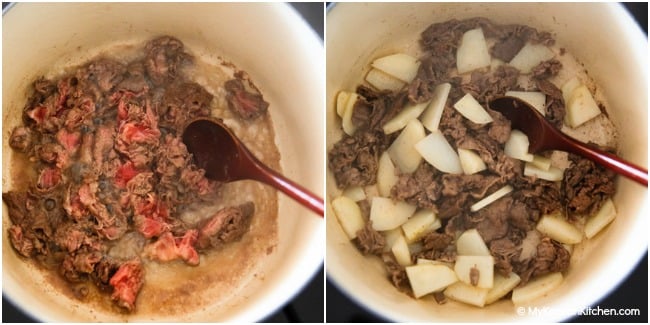
2. Pour over the rice water and start boiling. Add doenjang (Korean soybean paste) and ssamjang (Korean spicy dipping sauce) into the water, using a sieve, so it is easier to dissolve. Add gochugaru (Korean chili flakes) and garlic. Stir around.
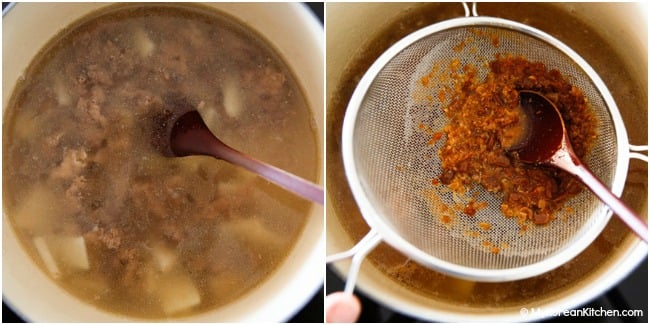
3. Once the water starts rolling boiling, add the zucchini and onions. Boil for 1 min. Add the mushrooms and tofu then boil for 1 min. Add green onions and chilies and boil a further 1 min. Remove from the heat.
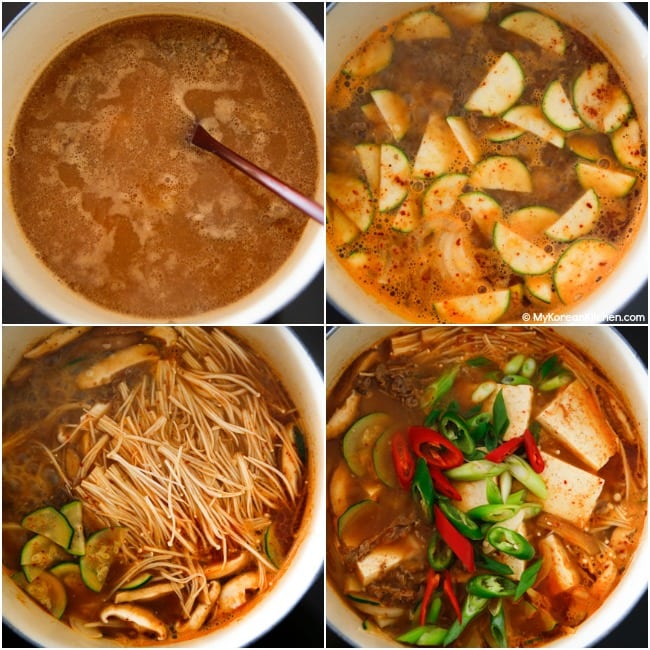
4. Serve with steamed rice and other Korean side dishes. (i.e. the side dish below shows – Korean egg roll, seasoned seaweed, radish kimchi)
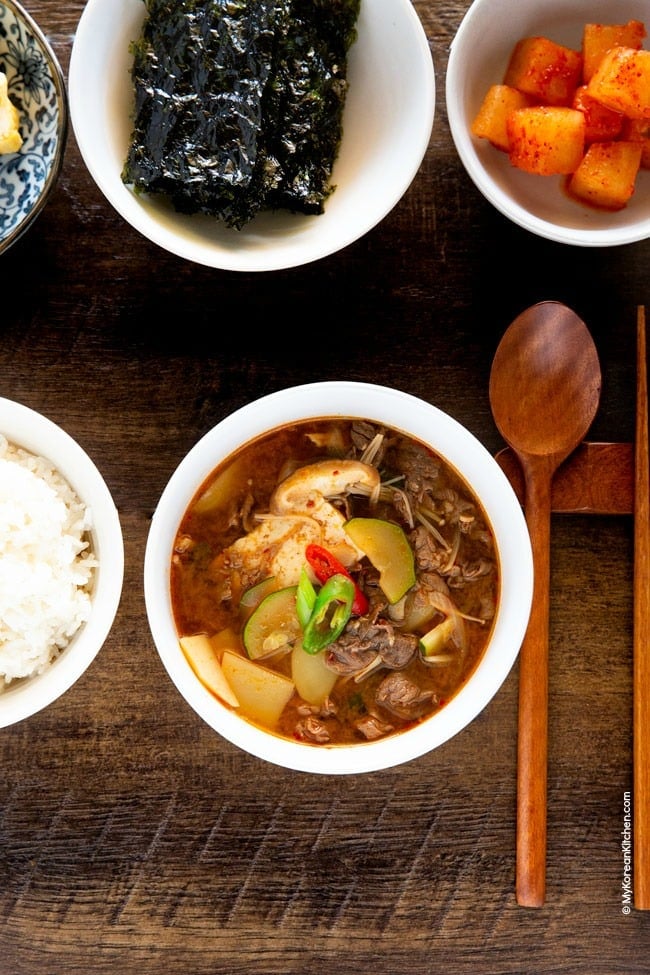
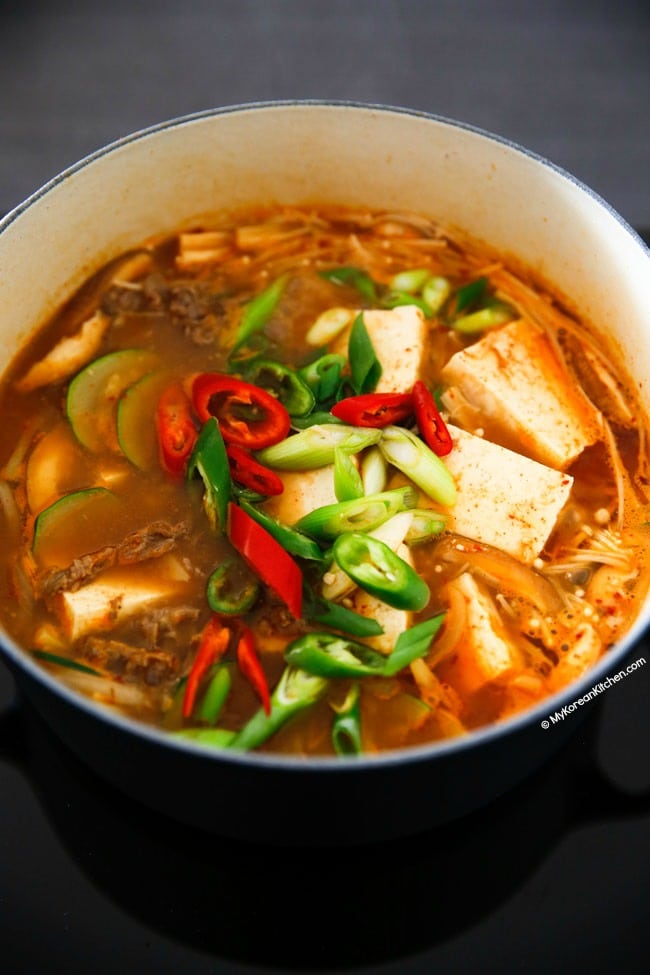
Do you like Korean stew? If so, why not try my most popular kimchi jjigae recipe?
Love Korean food? Browse my other Korean recipes from here. And subscribe to my newsletter and follow along on Facebook, Pinterest and Instagram for all of the latest updates.
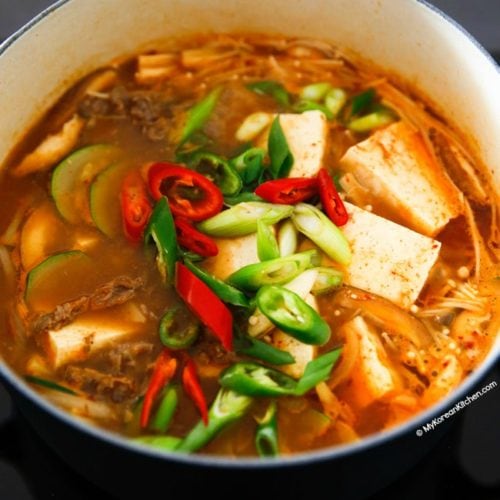
Doenjang Jjigae (Korean Soybean Paste Stew)
Ingredients
- 160 g beef brisket or any cuts that are suitable for soup and stew, (5.6 ounces), thinly sliced (ideally paper thin) and cut into bite size pieces
- 2 Tbsp rice wine (mirim)
- A few cracks ground black pepper
- 3.5 cups rice water , obtained by rinsing rice
- 3 Tbsp doenjang (Korean soybean paste)
- 1 Tbsp ssamjang (Korean spicy dipping sauce)
- 2 tsp gochugaru (Korean chili flakes)
- 1 tsp minced garlic
- 100 g potato (3.5 ounces), all rounder variety, thinly sliced
- 90 g zucchini (3.1 ounces), thinly sliced
- 35 g onion (1.2 ounces), thinly sliced
- 100 g enoki mushrooms (3.5 ounces), stems removed and separated
- 45 g shiitake mushrooms (1.5 ounces), thinly sliced
- 250 g tofu (8.8 ounces), sliced into medium rectangle pieces
- 20 g green onions (0.7 ounces), thinly sliced
- 2-3 chilies (optional), green and red, thinly sliced
Instructions
- Combine the beef with rice wine and black peppers in a bowl. Mix them well. Preheat a medium sized pot briefly over medium high heat. Add the meat and stir. (You won’t need to add any oil as the meat should have some fat attached to it.) Cook until it browns. Add the potatoes and stir for about 2 mins.
- Pour over the rice water and start boiling. Add doenjang (Korean soybean paste) and ssamjang (Korean spicy dipping sauce) into the water, using a sieve, so it is easier to dissolve. Add gochugaru (Korean chili flakes) and garlic. Stir around.
- Once the water starts rolling boiling, add the zucchini and onions. Boil for 1 min. Add the mushrooms and tofu then boil for 1 min. Add green onions and chilies and boil a further 1 min. Remove from the heat.
- Serve with steamed rice and other Korean side dishes. (i.e. the side dish above shows – Korean egg roll, seasoned seaweed, radish kimchi)
Notes
Nutrition Info (per serving)
The nutrition information shown is an estimate provided by an online nutrition calculator. It should not be considered a substitute for a professional nutritionist’s advice.

